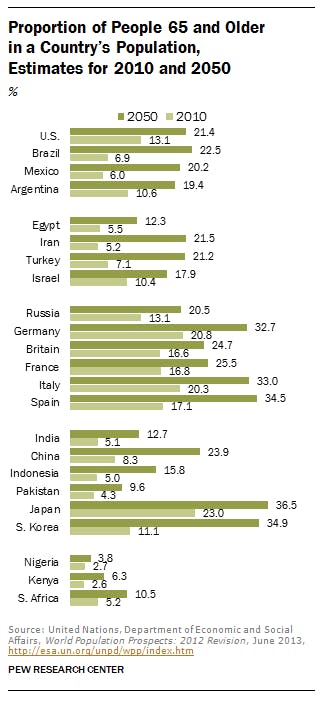This century, we’ll see some interesting demographic changes globally. While the population of most developed economies grow older and retire, their birth rates are shrinking and, as a result, the burden of social programs and welfare falls on a smaller pool of skilled workers.
According to Pew Research Center, by 2050, retirees will make up a significant proportion of the population of economies such as Japan (36.5%), South Korea (34.9%), Germany (32.7%), Brazil (22.5%), and the United States (21.4%). And with that comes slower economic growth and fiscal tightening as there are more retirees drawing from social security and ever fewer people to tax to fund those entitlements.
On the other hand, the developing world has a crop of youths learning valuable skills, and looking to emigrate to greener pastures. These low- and middle-income nations have a huge percentage of the youths under the age of 18, including India (30.6%), Nigeria (50.4%), the Democratic Republic of Congo (52.6%), Angola (54.3%), Gambia (52.8%),
Global mobility is the key to balancing the pendulum of demographic change and making sure the next generation of the world’s skilled workers can move easily to where their skills are most in demand. We’re going to examine Singapore, Germany, and the high-income Western European economies as models to help us establish why global mobility matters, even as the workforces of developed nations age and the need for skilled migrants increases.

A Profile of Singapore’s Struggle to Balance Overpopulation and Underpopulation
Singapore is the perfect example of galloping economic growth, a model for managing runaway population growth, and how a deliberate immigration policy can help stave off a demographic collapse.
At independence (1965), the city-state had very little going for it: its GDP per capita was ~$516, it was chronically overpopulated, and it had a sky-high birth rate (5.76 births per mother) that saw Singapore’s population almost double in the 13 years between 1957 and 1970.
To curb the country’s population explosion, the government launched a series of birth control programs that incentivized family planning with tax relief, housing discrimination, and a higher priority given to first- and second-born kids in Singapore’s education system.
And it worked—a little too well, too: from an all-time high of just under six births per woman, Singapore’s fertility rate has dropped to 1.1 births per woman. This has solved the overpopulation problem, and created an equally thorny issue.
As Singapore’s population growth rate slowly peaked, their economic growth took off, with GDP per capita growing to a peak of $72,794 in 2021 (No. 11 globally)—an astonishing 14,458% growth rate over the past 56 years. That level of growth requires an increasing number of young professionals joining the workforce every year to sustain it.
Unfortunately, Singapore’s birth rate is significantly below the 2.1 births per woman that’s needed to naturally replace the country’s aging population with younger professionals who can keep the country’s economy growing competitively.
And it’s a bigger problem for Singapore because, unlike its peers such as Germany, Japan, Denmark, etc., Singapore lacks any natural resources — it’s a tiny island of just 728.6 km² — and the country’s rapid economic strides have been built on the backs of a highly-trained workforce of knowledge workers—engineers, developers, doctors, designers, bankers, and investment analysts.
So, as Singapore’s population ages, economic growth has inevitably slowed—in fact, Singapore is projecting a measly 1.5% growth rate for 2024, down from an all-time high of 14.5% in 2010.
Let’s deconstruct the situation as it currently stands:
- Singapore needs a growing number of skilled workers to shore up their workforce, grow their economy, and prevent a shrinking economy, and
- Native Singaporeans are not having enough kids to sustain the required growth
To solve this problem, the Singaporean government has developed a deliberate immigration policy that makes up for the shortfall in natural births. As Singapore’s birth rate commenced a downward trend, immigration picked up, and by the 1990s, outpaced natural births (325,887) as the biggest contributor to Singapore’s population growth with more than 654,868 immigrants arriving between 1990 - 2000.

In 2013 the government of Singapore released a controversial brief titled A Sustainable Population for a Dynamic Singapore: Population White Paper that projects a population of 6.9 million by 2030 and plans for 30,000 permanent residents and 25,000 naturalized citizens per year as the only way to avoid a demographic situation where there are too few taxpayers bearing up a growing population of retirees.
Is Western Europe Headed For A Demographic Nightmare?
With a $4.26 trillion GDP, Germany is easily Western Europe’s largest economy and the region’s political behemoth—it’s the centerpiece that keeps the EU together and boasts a strong economy with manufacturing, energy, and service industries.
But, maybe not for long: as Germany's workforce ages, fewer kids are being born to replace them, guarantee economic growth, shore up the tax base, and fund the benefits owed to the 20 million retirees expected by 2035.
According to a report by the Institut der Deutschen Wirtschaft Köln, i.e., the German Economic Institute, Germany had a shortfall of 320,000 STEM professionals in 2022; the Ifo Institute for Economic Research estimates that 49.7% of German companies are affected by talent shortages, while the Bundesagentur für Arbeit, the Federal Labour Agency projects that Germany will need an extra 400,000 immigrant workers annually, or it will suffer a shortfall of 7 million skilled workers by 2050 (Center for Global Development).
Because of this shortfall, Industrial giants such as Airbus SE, BMW AG, and BASF SE are cutting output due to staffing shortages and it’s costing the German economy $85 billion annually.
It’s not a problem that’s unique to Germany —across the world, whether it’s in Scandinavia, Southeast Asia, or Western Europe, when you combine an aging population, shrinking birth rates, and a need to sustain the welfare state, immigration is the most sensible path to sustained growth.
An extensive study conducted by the United Nations shows that Europe will have 95 million fewer working-age people (between age 20 and 64) in 2050 than in 2015— already countries such as Latvia, Denmark, Greece, Turkey, and Ireland are facing labor shortages of varying severity — and the continent will need 44 million workers by 2050 to make up the gap.
The Global North is Facing a Demographic Crisis
To sum up our observations so far, it appears there’s a slightly predictable demographic pattern most developed nations have followed in the 20th and 21st century.
- As a country begins to industrialize, its GDP takes off, leading to a higher standard of living and growing household wealth for individuals.
- With liberal social and economic policies in place, more women join the workforce and have fewer kids to suit their lifestyle; as birth rates drop, economic productivity grows even further
- But, that growth eventually peaks and as aged professionals begin to retire, the demographic balance begins to shift—there are fewer kids being born, and therefore fewer working professionals for every retiree and welfare recipient.
- To balance it out, governments can either cut entitlements or look beyond their borders for skilled immigrants who can make up for the shortfall, shore up their tax base, and keep the economy growing
The Global South is Recording a Population Surge That Can Makeup For The North’s Labour Gap
While birth rates in the Global North fall and most high-income nations report record labor shortages, their developing peers are still early into the industrialization process. Just like most Western countries a century ago, they have:
- A rapidly-growing population thanks to a high birth rate
- A huge youth population, with anywhere from 40% - 60% of the population under 18
- Record unemployment levels, as a result of poor infrastructure, corruption, relative overpopulation, and political instability that’s made skilled professionals in the developing world eager to immigrate
For instance, in Nigeria there’s a growing trend of young professionals and students looking to japa, a playful Yoruba word for run away or escape, and in 2022, the Nigeria Immigration Service (NIS) issued a total of 1,899,683 passports to emigrants on their way out or hopefuls planning to join the 14+ million Nigerians in diaspora.
By 2030, the United Nations projects that there'll be 1.3 billion people on the planet between ages 15 - 24. Africa holds the bulk of that population, and according to this chart, 28 out of the 30 countries with the majority of their population (i.e., 48% - 56%) under the age of 18 are African nations. And contrary to what the media might have you believe, immigrants tend to be exceptionally successful in their careers.
Asian Americans are the United States’ highest earners by ethnicity ($100,572 per year). Additionally, according to the Migration Policy Institute, 29% of Nigerian-Americans over age 25 hold a graduate degree, compared to 11% for the general population. Migrants are America’s most-educated population and are more likely to attain bachelor's, masters, or doctorate degrees.
Global mobility solves the labor shortage problem caused by aging populations by offering skilled workers in younger countries better prospects.
Global Mobility Solves the Twin Problems of Labor Shortages & Runaway Unemployment
As remote work goes mainstream, businesses and governments are finally taking drastic steps to hire talent across borders. Even better, they’re actively encouraging skilled workers from developing nations to relocate, using remote work and employment-based immigrant visas.
Countries across Europe, the Caribbeans, and the Americas have reduced the barriers to entry with digital nomad visas, work permits, and green cards that target skilled professionals from across the world.
Essentially, global mobility balances out the world’s demographic challenges— it provides a source of fresh talent and serves as a haven for skilled professionals from younger populations looking to put their skills to use.
As your team grows, it’s important—critical even—to look beyond your borders for the right talent. Hiring internationally can help you create a diverse culture and create a truly global presence.
Localyze is here to help make moving international talent as easy as possible. Our global mobility platform walks both employees and HR through every step of the visa process, while providing personalized support along the way.



